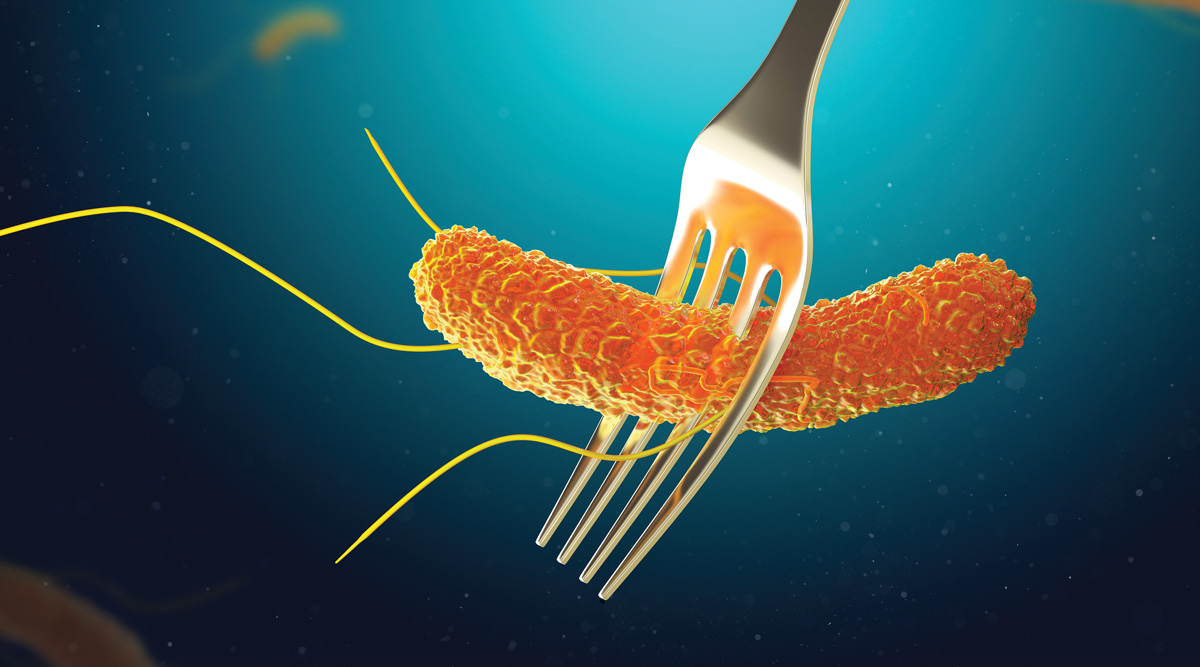Can the prevalence of Salmonella in raw chicken be reduced?
 On January 26, 2015, the USDA/FSIS announced a new pathogen reduction performance standards for Salmonella. They also announced that they would begin sampling raw chicken parts to gain additional information on the prevalence and the microbiological characteristics of Salmonella.
On January 26, 2015, the USDA/FSIS announced a new pathogen reduction performance standards for Salmonella. They also announced that they would begin sampling raw chicken parts to gain additional information on the prevalence and the microbiological characteristics of Salmonella.
The standard for chicken parts permitted a 15.4 % positivity rate for large production establishments. In lower-volume establishments, an adjusted positive rate to their production volume was established.
New standards were established for raw chicken parts and not-ready-to-eat (NRTE) comminuted chicken and turkey products. The FSIS began assessing whether establishments met the new pathogen reduction standards for chicken parts, comminuted chicken and turkey products on May 11, 2016.
The Goal
The new standards were chosen to achieve a 30 % reduction in the occurrence of Salmonella-contaminated chicken parts samples (i.e., legs, breasts, or wings).
FSIS Test results

Recently the agency published (Williams et al. Assessing the effectiveness of performance standards for Salmonella contamination of chicken parts. International Journal of Food Microbiology Vol. 378, October 2, 2022) the results of their study.
The data demonstrated over 75% reduction in Salmonella contamination of chickens. A similar reduction in Salmonella was shown in chicken parts collected at retail. The study found that the intended 25 % reduction of Salmonella contamination was probably achieved for minced turkey. For minced chicken, the estimated reductions were less than the predicted 25 %.
Small but significant seasonal increases in contamination were noticed. The peaks happened in late winter rather than the more traditional late summer peak. The researchers also observed a rapid change in the five most common serotypes and antimicrobial resistance patterns.
One interesting element of the study is the growing importance of Salmonella Infantis in its frequency and antimicrobial resistance in the US.
However, the reduction in the presence of Salmonella did not result in a reduction in Salmonella illnesses. Each year more than a million people get sick with Salmonella in the US, and 20% of the illnesses are attributed to poultry. Salmonella in poultry remains a significant food safety concern.
Consumer Report data

On June 30, 2022, Consumer Report (CR) published their data on the testing of 351 packages of ground meat. They found that 1/3 of the chicken was contaminated with Salmonella (23 samples out of75 tested). CR found Salmonella in ground chicken from various brand names such as Perdue, Trader Joe’s, Wholesome Pantry, Walmart, and Whole Foods. Overall, no single brand stood out as being statistically better or worse than another.CR found no difference in contamination between ground meat from organic chicken and meat from conventionally chicken. It was worrisome to CR that all strains of Salmonella they tested were resistant to at least one antibiotic.
The USDA/FSIS identified three strains of Salmonella that are most important in poultry: infantis, typhimurium, and enteritidis. In CR’s test, 91% of the Salmonella detected in ground chicken was from those three strains.
CR is especially concerned about ground meats. When a chicken breast is contaminated with Salmonella, it usually resides on the surface, where it can be easily killed during cooking. But minced chicken gets the Salmonella mixed throughout, making it much more difficult to be killed if not properly cooked. Also, handling the mix causes the hands to get contaminated and contaminate other surfaces.
CR feels that FSIS should treat the Salmonella issue in chicken with much more urgency because Salmonella in ground poultry is more common than it should be. Actually, Salmonella in poultry is a bigger problem than E. coli in meat.
CR complains about the USDA allowing Salmonella in up to 9.8% of whole birds it tests, 15.4% of parts, and 25% of ground chicken. The punishment for exceeding these levels is a warning, not a stop in production. Larger, more systematic changes are required now.
Dr. Price (Director of Antibiotic resistance Center at Georgetown University, Washington DC) suggests that the best way to reduce Salmonella in chickens is to reduce the number of chickens that carry Salmonella in the first place and for the USDA/FSIS to declare the bacteria to be adulterants. However, he acknowledges that it is unlikely to happen. The possible alternative is to reduce the percentage of allowed plosive samples for Salmonella.
FSIS to create risk assessments for Salmonella in poultry

The USDA is rethinking its strategy to most effectively reduce Salmonella in poultry. The USDA/FSIS are collaborating with the University of Maryland’s Joint Institute for Food Safety and Applied Nutrition and EpiX Analytic in developing a risk assessment model for Salmonella in poultry. The model will allow determining the impact of monitoring and enforcing control through the manufacturing process.
To conduct the risk assessment, some questions need to be answered to evaluate and compare the public health benefits of policy options for controlling Salmonella in poultry. For example, is the public health impact (change in illnesses, hospitalizations, and deaths) achieved by eliminating specific levels of Salmonella at the receiving? What is the impact of certain levels of Salmonella on the final product and the impact of specific subtypes? What is the impact of monitoring/enforcing process control from re-hang to post-chill? What is the public health impact of combinations of the risk management options listed above?
The USDA/FSIS have partnered with bioMérieux to use in its laboratories the GENE-UP®QUANT system (the first non-enrichment quantification diagnostic for Salmonella that got AOAC approval) as a tool to determine levels of Salmonella in poultry. The quantification of Salmonella is part of the agency effort to reduce the pathogen in poultry, by knowing the amount of Salmonella and not just presence absences. A total eradication of Salmonella in raw poultry is unrealistic. However, a key question is if risk assessment will point the USDA in the right direction and can the risk of Salmonella be significantly reduced?
